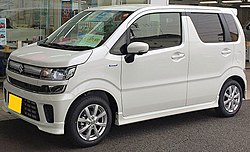Applications
Kei cars
- Suzuki Alto / Mazda Carol — HA36S/V (2014–2021)
- Suzuki Alto / Mazda Carol — HA37/97 (2021–present)
- Suzuki Lapin (2015–present)
- Suzuki Wagon R / Mazda Flair (2017–present)
- Suzuki Spacia / Mazda Flair Wagon — MK53S (2017–2024)
- Suzuki Spacia / Mazda Flair Wagon — MK54S (2023–present)
- Suzuki Hustler / Mazda Flair Crossover (2020–present)
- Suzuki Wagon R Smile (2021–present)
- Suzuki Hustler
- Suzuki Alto (HA36S/V)
- Suzuki Alto (HA37/97)
- Suzuki Lapin
- Suzuki Wagon R
- Suzuki Spacia (MK53S)
- Suzuki Spacia (MK54S)
- Suzuki Wagon R Smile
Subcompact cars
- Suzuki Baleno / Toyota Glanza / Starlet — WB1 (2015–2022)
- Suzuki Baleno / Toyota Glanza / Starlet — WB2 (2022–present)
- Suzuki Solio / Mitsubishi Delica D:2 — MA26S/36S/46S (2015–2020)
- Suzuki Solio / Mitsubishi Delica D:2 — MA27S/37S/D7S (2020–present)
- Suzuki Ignis (2016–present)
- Suzuki Swift — A2L (2016–2023)
- Suzuki Swift — AOL (2023–present)
- Suzuki Dzire (2017–2024)
- Suzuki Dzire (2024–present)
- Suzuki Xbee (2017–present)
- Maruti Suzuki Wagon R (2019–present)
- Suzuki S-Presso (2019–present)
- Suzuki Celerio / Toyota Vitz (2021–present)
- Maruti Suzuki Alto K10 (2022–present)
- Suzuki Fronx / Toyota Urban Cruiser Taisor/ Starlet Cross (2023–present)
- Suzuki Baleno (WB1)
- Suzuki Baleno (WB2)
- Suzuki Solio (MA26S/36S/46S)
- Suzuki Solio (MA27S/37S/D7S)
- Suzuki Ignis
- Suzuki Swift (A2L)
- Suzuki Swift (AOL)
- Suzuki Dzire
- Suzuki Dzire
- Suzuki Xbee
- Maruti Suzuki Wagon R
- Suzuki S-Presso
- Suzuki Celerio
- Maruti Suzuki Alto K10
- Suzuki Fronx
Compact cars
- Suzuki Ertiga / Toyota Rumion (2018–present)
- Suzuki XL6/XL7 (2019–present)
- Suzuki Ertiga
- Suzuki XL6
- Suzuki XL7
Heartect-e
- Suzuki e Vitara / Toyota Urban Cruiser (2025; to commence)
- Suzuki e Vitara


























